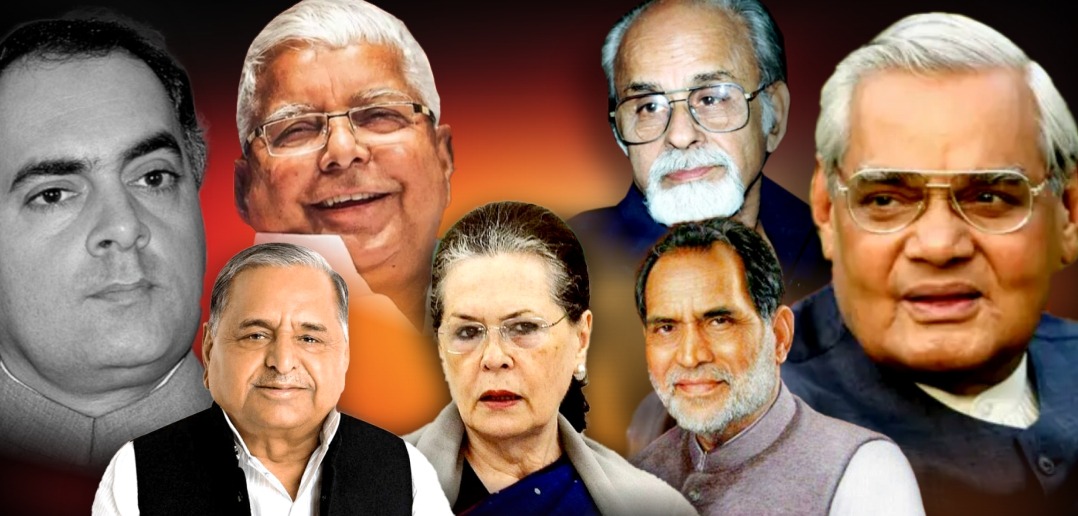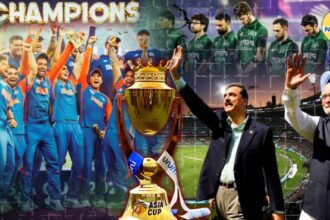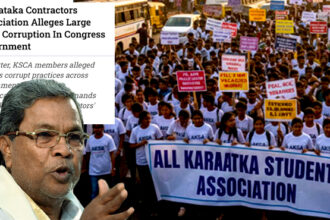Rahul Gandhi is very clear in his objective. The objective is to create so much doubt in people’s minds about the country’s constitutional institutions that another regime change movement is triggered in India. Taking cue from Nepal’s so-called Gen-Z protests, Rahul Gandhi even started using the term for India’s youth.
देश के Yuva
— Rahul Gandhi (@RahulGandhi) September 18, 2025
देश के Students
देश की Gen Z
संविधान को बचाएंगे, लोकतंत्र की रक्षा करेंगे और वोट चोरी को रोकेंगे।
मैं उनके साथ हमेशा खड़ा हूं।
जय हिंद! pic.twitter.com/cLK6Tv6RpS
Rahul Gandhi and other Congress supporters are rooting for a Nepal-like protest in India that can overthrow the democratically elected government. And while Rahul Gandhi claims to be standing with Gen Z of India, is Gen Z even standing with him? Does he even have the credibility? Well, we will leave that decision to you. But let us analyse what exactly was the Nepal movement that Rahul Gandhi seems to be wanting to replicate in India.
While Nepal government collapsed following the so-called Gen Z protests, the vacuum created was quickly filled. Interim government was quickly formed and next date of elections was also announced. This shows the maturity not only of the protesting students but also of Nepali society.
Since such a movement in Nepal occurred a year after the regime change in Bangladesh, the comparison was natural. People feared that Nepal might reach a point like Bangladesh, where policy decisions or indecision would become a burden for the interim government. Such a situation has persisted in Bangladesh for the past eight months. People are unsure whether elections will be held, and if so, when.
Another topic of debate in Bangladesh is what mandate the Mohammad Yunus-led interim government has to do. To what extent is military intervention possible or should it be? These questions have arisen because the Yunus government reportedly wants US intervention to take decisions that will have long-term impacts on Bangladesh’s politics, society and even geography.
In Nepal’s case,Sushila Karki, who is heading the interim government, has previously served as Chief Justice of the country’s Supreme Court. As Chief Justice, she understands the importance of taking and adhering to the Constitutional Oath. Bangladesh’s Mohammad Yunus has had no such experience prior to becoming the caretaker chief.
In his case, some religious and cultural aspects are also involved, but that is a separate topic.
The reasons behind what happened in Nepal have been widely discussed. When the objective of politicians is simply to form a government and remain in power, such a situation is bound to arise. Nepal has seen more than a dozen governments in the past seventeen years. The distinction between who was colluding with whom to secure the public’s votes and who was forming the government had vanished. Nepal is a prime example of how a country can be deceived in the name of democracy, its citizens betrayed. No country, large or small, can tolerate such political instability.
Now let us talk about political instability. The prerequisite for democracy is stability, and that’s why every democracy has a fixed term, five or four years, for government. Any government and its voters use this fixed term for correction when needed. But what happens when the sole objective of political parties and politicians is to remain in power by any means necessary? What Nepal has experienced over the past fifteen years would be a horrible situation for any country. And what happened when the situation went out of control was witnessed by the entire world.
The political situation in Nepal today reminds us of India in the 1990s, when political instability was the established norm. In the name of coalitions, experiments were conducted in India, both at the Centre and in the states. Just the very reminder of them sends shivers down our spines. So those who are wishing a Nepal-like situation in India, have forgotten how India in the 1990s was almost identical.
Let us take a walk down the memory lane and go back to the India of 1990s. Following the Indira Gandhi imposed Emergency, a new political formation, the Janata Party formed government at the Centre. Morarji Desai’s government was toppled to make way for Chaudhary Charan Singh as Prime Minister. This, too, was subsequently toppled. Thankfully, the political instability in the 1990s was short-lived as soon Indira Gandhi came to power. No governments collapsed. She stayed Prime Minister of India till 1984 when she was assassinated. Following her assassination, her son Rajiv Gandhi became India’s prime minister.
But in the 1989 elections, Congress, led by Rajiv Gandhi, lost. There was controversy over who would become Prime Minister from the Janata Dal as both, Chandrashekhar and VP Singh, wanted to become the prime minister. In this tussle, everyone looked to Chaudhary Devi Lal, who claimed to be the leader of farmers. He supported VP Singh, and Devi Lal became Deputy Prime Minister in the government formed under VP Singh’s leadership. In a contradictory move, this government had the support of the BJP as well as the Left. Later, to counter the Ram Mandir movement, VP Singh implemented the Mandal Commission report, and this resulted in widespread unrest in society. VP Singh’s government was subsequently voted out in Parliament.
VP Singh’s Deputy Prime Minister, Devi Lal, now sided with Chandrashekhar because the Congress had promised Chandrashekhar that it would support a government led by him. This was the same playbook the Congress had followed during the tenure of Chaudhary Charan Singh. The same fate befell Chandrashekhar as it had befallen Charan Singh. Within six months, the Congress withdrew its support, and Chandrashekhar’s government also fell.
Then came the 1991 elections, during which Rajiv Gandhi was assassinated during the campaign. The Congress formed a government under the leadership of Narasimha Rao. It was a minority government. A minority government is the one in which a political party or a coalition of parties holds office despite not having the majority of seats in the Lok Sabha. Despite being single largest party, Congress did not have enough numbers to form a majority government. Rao did not form a formal coalition and led the Congress government via external support of other regional parties such as Samajwadi Party and other smaller parties. This was the first minority government to complete full term.
Despite being the Prime Minister, Narasimha Rao gave weekly updates to Sonia Gandhi regarding the government’s progress. This was also the same government where, for the first time, MPs’ votes were bought to save the government. This later came to be known as the JMM bribery case. It was proven that the Congress had bought the MPs’ votes needed to save the government with cash.
The case went to the Supreme Court, but at that time, the Supreme Court was less supreme and it simply stated that there was evidence that votes were bought through bribery but the Parliament is supreme and nothing can be done about a scandal that occurred within Parliament. The Supreme Court reviewed this very decision in 2024 and declared that the previous decision was void because Parliament is not supreme in matters of corruption.
Moving on, in the 1996 elections, the BJP won the highest number of seats, 165. The President invited the BJP to form a government. A government led by Atal Bihari Vajpayee was formed, but because it failed to secure a majority, it collapsed within thirteen days. Vajpayee then addressed the question of morality in democracy, saying:
Vajpayee’s first government fell, and the same power struggle that has played out in Nepal over the past decade and a half began. Following the fall of the Vajpayee government, a government was formed under Deve Gowda’s leadership, supported by dozens of parties. The story of who supported him and from where is a long one, but you can get a sense of Indian politics at the time from this speech given by Pramod Mahajan in Parliament:
Deve Gowda’s government then lasted until April 1997. Why? Because the Congress played the same trick it had played with Charan Singh and Chandrashekhar. Meanwhile, Lalu Yadav broke away from the Janata Dal and formed the Rashtriya Janata Dal. Lalu Yadav also blackmailed Deve Gowda. Since the fodder scam had already come to light, he got Joginder Singh appointed as the CBI chief. Lalu Yadav needed a “friendly CBI chief.” To remain in power, Deve Gowda had to compromise. It’s another matter that Lalu Yadav later imposed his trusted and highly controversial leader, Taslimuddin, on Deve Gowda. This was met with widespread opposition. Deve Gowda lost Lalu Yadav’s support.
Lalu Yadav split the Janata Dal and subsequently supported the government led by I.K. Gujral. The reason was that after being implicated in the fodder scam, he had no choice but to remain in the good graces of the central government. However, he later had to resign as Chief Minister of Bihar. He didn’t give up and appointed his wife, Rabri Devi, as Chief Minister of Bihar. This was an unprecedented political move, perhaps beyond the imagination of the common citizen or voter.
The Gujral government later fell. Why? It was the same old game of Congress. It played the same trick with Gujral as it had with Charan Singh, Chandrashekhar, and Deve Gowda. Some claimed that the then Congress President, Sitaram Kesri, wanted to become Prime Minister himself. Former President Pranab Mukherjee also wrote about this in his book. And what excuse was publicly presented? The excuse was that I.K. Gujral should expel the DMK from his government because the Jain Commission, which investigated Rajiv Gandhi’s assassination, had held the DMK responsible for his assassination in its report.
Just imagine the factors that formed and destroyed governments. People would unite in the name of blind opposition to the BJP and defending secularism, only to fall out due to personal ambition, whether it was Sitaram Kesri, Lalu Yadav, or Rajiv Gandhi.
And this trend didn’t end in 1997. The way Vajpayee’s government was toppled by a single vote on the floor of Parliament was astonishing. Subramanian Swamy, a politician who opposes Sonia Gandhi today, toppled the Vajpayee government by arranging a meeting between Sonia Gandhi and Jayalalithaa and Mayawati, who supported the Vajpayee government. Why? Because he had personal ambitions. Interestingly, this same Subramanian Swamy was once Jayalalithaa’s biggest enemy. Three years before he persuaded Jayalalithaa to topple the Vajpayee government, he had moved the Supreme Court against her. The situation was such that he had to go to the Supreme Court to protect his life from Jayalalithaa.
So, this was the political situation in the 1990s. Congress withdrew support from the Gujral government because it didn’t want the DMK in power. Today, the situation is such that for the past twenty years, it can’t even imagine its life without the DMK. And what was the result? The massive 2G scam perpetrated by DMK minister A Raja.
The government that formed in 2004, after the BJP failed to return to power under Vajpayee’s leadership, was also a coalition. Interestingly, this wasn’t a pre-election coalition, but rather a post-election coalition where people came together in the name of protecting secularism. If this wasn’t disrespectful of the common people’s vote, what was it?
In 2008, when the Left split from the Congress over the nuclear deal, the Samajwadi Party came to support the Congress. The entire country witnessed how cash was exchanged for votes in Parliament and how Rajdeep Sardesai covered up the sting operation.
The scams, corruption, and policy paralysis that this country witnessed after that were beyond the imagination of any ordinary Indian. Whether it was in name of protecting secularism or defeating communalism or even in name of saving democracy, India’s democracy was actually severely damaged. The public voted for one person, and after the election results, the mandate was stolen by someone else.
Furthermore, the Congress government has repeatedly dismissed governments from power in states using flimsy allegations. The Congress party’s faith in democracy can be gauged from the fact that in a state like Bihar, Congress ruled for much of the 1990s, but no Chief Minister could complete his full term. And there’s no need to delve too far into history. We can see the confusion surrounding the election campaign being run jointly by Rahul Gandhi and Tejashwi Yadav. One day, they campaign together, and the next, Tejashwi Yadav declares that his party will contest all seats. Is this how Rahul Gandhi wants to save and protect democracy?
The country witnessed how Dr. Manmohan Singh ran the UPA government. This was the same government whose support, in return, helped the Communists secure a base for the Left in Nepal. Today, the same Congress party is telling the country that because it is out of power and Gandhi family scion, Rahul Gandhi, is unable to become Prime Minister on his own merit, democracy has left the country and gone to Rwanda.
While this may be considered a generalization, it cannot be denied that the political system that Nepal has suffered from over the past decade and a half has also been influenced by Indian communist and Congress leaders. The kind of politics that was promoted, or rather, nurtured, in the name of protecting democracy is the result of this movement in Nepal. It cannot be denied that external forces are involved, but it is also true that external forces will only succeed if gates are opened from inside the fort for them to enter.
And today, Rahul Gandhi wants to implement the same Nepal playbook in India. The reason is that he is unable to find a political solution to the problem of his inability to return to power.
As said earlier, the first requirement of democracy is stability. This stability gives a country’s democracy time to flourish. The instability we have seen in India for the past eleven years has troubled many leaders, parties, and powers.
But the truth is, this need for stability is a traditional, or rather, classical, view for a mature democracy. The democracy that America, the self appointed leader of the world for the past twenty years, has been trying to establish globally is a new kind of democracy. It’s so new that, in India, with a population of 140 crore, it relies on the opinions of 250 people to assess its quality.
According to the traditional definition of democracy, democracy is all about having different views, yet reaching a consensus to work smoothly. It’s about establishing dialogues to run a show. But according to today’s America, democracy is all about dissent. If you don’t have dissenting people who can create chaos, you are less democratic or you are autocratic.
Using this new version of democracy, America has taken upon itself the responsibility of establishing its own type of democracy worldwide, and Rahul Gandhi and company want the same. The Congress party, which gave the country every kind of politics and caused every kind of harm, is the same Congress party whose leader is now telling the country that democracy no longer exists.
So now the battle is between the country and Congress. It remains to be seen whether the country wins or Congress.






